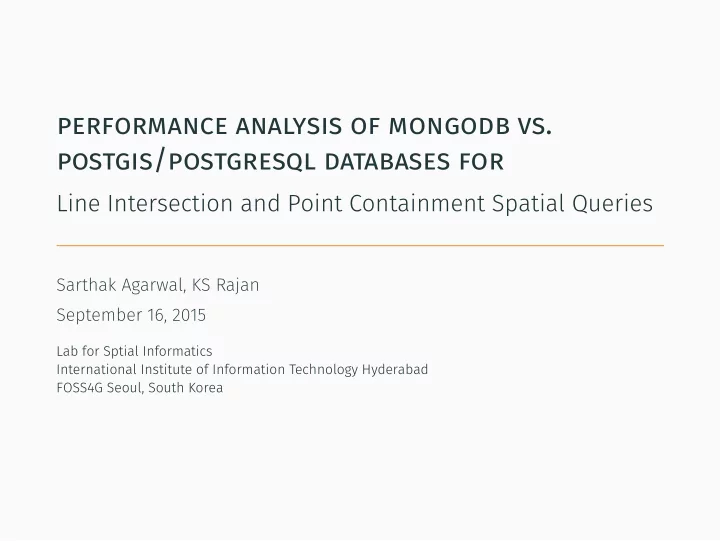

Line Intersection and Point Containment Spatial Queries Sarthak Agarwal, KS Rajan September 16, 2015 Lab for Sptial Informatics International Institute of Information Technology Hyderabad FOSS4G Seoul, South Korea performance analysis of mongodb vs. postgis/postgresql databases for
Why do we need a Internet connection to know directions from one point to another? Why not deploy the server on the mobile device itself? Why to query heavy SQL servers everytime? FOSS4G Seoul, South Korea | September 14th – 19th , 2015 Sarthak Agarwal, KS Rajan 2 Problem Statement
∙ Spatial databases currently are primarily based on RDBMS. eg PostGIS ∙ They have a great potential to store, manage and query very large dataset. ∙ SQL databases face scalability and agility challenges. ∙ Spatial applications do not always have a fixed schema every time. FOSS4G Seoul, South Korea | September 14th – 19th , 2015 Sarthak Agarwal, KS Rajan 3 Spatial Databases
∙ PostgreSQL is an open source, object-relational database management system (ORDBMS). ∙ PostGIS adds support for geographic objects to the PostgreSQL object-relational database. ∙ The functions of PostGIS can be divided into 5 broad categories- ∙ Management. ∙ Conversion. ∙ Retrieval. ∙ Comparison. ∙ Generation. FOSS4G Seoul, South Korea | September 14th – 19th , 2015 Sarthak Agarwal, KS Rajan 4 PostgresSQL/PostGIS
∙ They have a great potential to store, manage and query very large dataset. ∙ They performs better in cases ∙ where there is a need to improve the query response time ∙ can handle the rise in the data storage and frequency at which it is accessed and processed. ∙ Spatial applications deals with problems like over time evolution of schema and data size FOSS4G Seoul, South Korea | September 14th – 19th , 2015 Sarthak Agarwal, KS Rajan 5 Spatial Databases ∙ NoSQl or Not only Sql databases for non-relational data stores.
∙ Document oriented datastore. ∙ High performance and retains friendly properties of SQL. ∙ GeoJSON objects. ∙ Multiple geospatial indexes per collection - 2d, 2dsphere . ∙ Data can be imported from CSV files by converting it into GeoJSON objects. ∙ No support for R trees. FOSS4G Seoul, South Korea | September 14th – 19th , 2015 Sarthak Agarwal, KS Rajan 6 MongoDB
∙ Not designed for distributed System ∙ Good for structured data Unstructured data, points and lines not very suitable. ∙ Distributed Databases spread over multiple servers, ∙ Schema less databases where multiple geometries can be stored in the same column. FOSS4G Seoul, South Korea | September 14th – 19th , 2015 Sarthak Agarwal, KS Rajan 7 Comparison SQL NoSQL
Does NoSQL hold a promise in the context of Spatial Databases and Spatial Queries? FOSS4G Seoul, South Korea | September 14th – 19th , 2015 Sarthak Agarwal, KS Rajan 8
∙ Conventional Databases. ∙ Geometry Databases. ∙ Point in a polygon ∙ Line Intersection FOSS4G Seoul, South Korea | September 14th – 19th , 2015 Sarthak Agarwal, KS Rajan 9 How to compare
∙ Synthetic dataset created for all cases. ∙ Test best case scenarios. ∙ Small data size to very big data size ∙ All the data in the analysis was processed using In-memory and no secondary memory was used. FOSS4G Seoul, South Korea | September 14th – 19th , 2015 Sarthak Agarwal, KS Rajan 10 Datasets
Sarthak Agarwal, KS Rajan FOSS4G Seoul, South Korea | September 14th – 19th , 2015 11 Performance
∙ MongoDB performs better as the datasize increases. ∙ PostGIS fails at very large datasets. ∙ Indexing increases the performance of both datasets. ∙ PostGIS time increases exponentially as size of dataset increases, whereas MongoDB still performs within some bounds. FOSS4G Seoul, South Korea | September 14th – 19th , 2015 Sarthak Agarwal, KS Rajan 12 Results
∙ These results suggest that MongoDB performs better by an average factor of 25x. ∙ Factor increases exponentially as the data size increases in both indexed and non-indexed operations. ∙ After observing these results NoSQL databases can be stated better suited for simultaneous multiple-user query systems including Web-GIS and mobile-GIS. FOSS4G Seoul, South Korea | September 14th – 19th , 2015 Sarthak Agarwal, KS Rajan 13 Discussions
∙ non-relational databases are more suited to the multi-user query systems ∙ potential to be implemented in servers with limited computational power. ∙ Further studies are required ∙ In future we are planning on expanding our study to other spatial query functions as well as spatial algorithms FOSS4G Seoul, South Korea | September 14th – 19th , 2015 Sarthak Agarwal, KS Rajan 14 Conclusion
Sarthak Agarwal, KS Rajan FOSS4G Seoul, South Korea | September 14th – 19th , 2015 15 Questions?
Recommend
More recommend